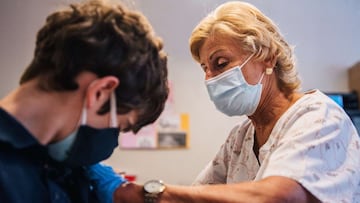How much does a registered nurse earn in US by hour: what is the average RN salary?
The US is in the midst of a healthcare crisis with a shortage of workers. How much do registered nurses get paid?


The United States is currently in the midst of a critical nursing shortage, caused in part by the huge strain placed on nurses and the healthcare system more broadly during the pandemic. The average wage of registered nurses has risen since the start of the pandemic but those increases are far below the rate of inflation in the United States.
Dr. Jason Shafrin, a senior managing director at the Center for Healthcare Economics and Policy points out: “Wages of registered nurses have increased a little over 2%,” referencing a recent study published in the journal Health Affairs. For context, inflation in the US is currently running above 8% year-on-year.
In 2021 the Bureau of Labor Statistics found that the median average pay for registered nurses (RN) is $77,600 per year. That works out as $37.31 per hour.
However the real figure vary greatly depending on a number of factors, including experience and geographical location. The top 10% of RNs earn more than $120,000 per year, while the lowest 10% earned less than $60,000. Typically the best-paid RN jobs are found in the government, where the median salary is more than $85,000.
| Industry | Median RN salary |
|---|---|
| Government | $85,970 |
| Hospitals; state, local and private | $78,070 |
| Ambulatory healthcare services | $76,700 |
| Nursing and residential care facilities | $72,420 |
| Educational services; state, local and private | $61,780 |
Nursing shortage could continue until 2030
Since the early 1900s the United States has suffered numerous periodic nursing shortages. Often these were spurred by a single event, such as a recession or world war, but the current nursing crisis is part of a broader problem.
As life expectancies have increased and the population has skewed older, the demand for nurses and healthcare in general has never been higher. The baby boomer generation (born between 1946 and 1964) are entering into old age and the nation now has more people aged 65 or older than at any point in its history.
In 2011 there were 41 million people aged 65+; by 2019 that figure had risen to 71 million.
Related stories
Healthcare has also become more accessible and more affordable, meaning that the proportion of people entitled to support has also grown. While these two trends – longer life expectancies and greater availability of healthcare – are undoubtedly positive, the failure to add the required trained staff to the healthcare system could prove costly in the years to come.
A study from the University of St. Augustine for Health Sciences found that the US would need an additional 1.2 million new registered nurses by 2030 to address the shortage. Failing to do so could leave vulnerable patients unable to get the support they need and could push up the price of coverage significantly.

